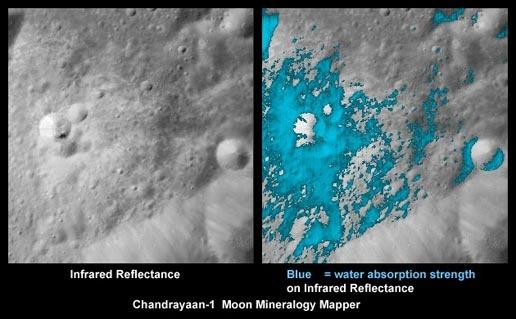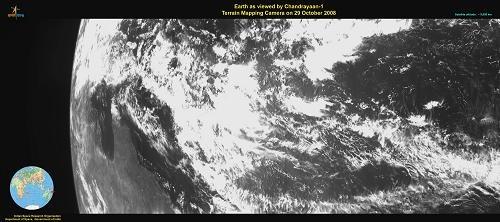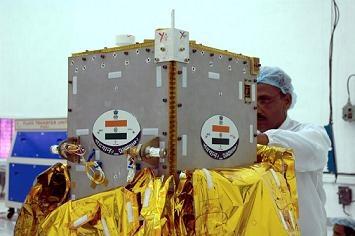Impact of the MIP on the lunar surface
The Moon Impact Probe (MIP) crash-landed on the lunar surface on 14 November 2008, 15:01 UTC near the crater Shackleton at the south pole. The MIP was one of eleven scientific instruments (payloads) on board Chandrayaan-1.
The MIP separated from Chandrayaan at 100 km from lunar surface and began its nosedive at 14:36 UTC. going into free fall for thirty minutes. As it fell, it kept sending information back to the mother satellite which, in turn, beamed the information back to Earth. The altimeter then also began recording measurements to prepare for a rover to land on the lunar surface during a second Moon mission.
Following the deployment of the MIP, the other scientific instruments were turned on, starting the next phase of the mission.
After scientific analyses of the received data from the MIP, the Indian Space Research Organisation confirmed the presence of water in the lunar soil and published the finding in a press conference addressed by its then Chairman G. Madhavan Nair.
Rise of spacecraft's temperature
ISRO had reported on 25 November 2008 that Chandrayaan-1's temperature had risen above normal to 50 °C (122 °F), Scientists said that it was caused by higher than expected temperatures in lunar orbit. The temperature was brought down by about 10 °C (18 °F) by rotating the spacecraft about 20 degrees and switching off some of the instruments. Subsequently, ISRO reported on 27 November 2008 that the spacecraft was operating under normal temperature conditions. In subsequent reports ISRO says, since the spacecraft was still recording higher than normal temperatures, it would be running only one instrument at a time until January 2009 when lunar orbital temperature conditions are said to stabilize. It was initially thought that the spacecraft was experiencing high temperature because of radiation from the Sun and infrared radiation reflected by the Moon. However the rise in spacecraft temperature was later attributed to a batch of DC-DC converters with poor thermal regulation.
Mapping of minerals
The mineral content on the lunar surface was mapped with the Moon Mineralogy Mapper (M3), a NASA instrument on board the orbiter. The presence of iron was reiterated and changes in rock and mineral composition have been identified. The Oriental Basin region of the Moon was mapped, and it indicates abundance of iron-bearing minerals such as pyroxene.
In 2018 it was announced that M3 infrared data had been re-analyzed to confirm the existence of water across wide expanses of the Moon's polar regions.
Mapping of Apollo landing sites
ISRO announced in January 2009 the completion of the mapping of the Apollo Moon missions landing sites by the orbiter, using multiple payloads. Six of the sites have been mapped including landing sites of Apollo 15 and Apollo 17.
Image acquisition
The craft completed 3,000 orbits acquiring 70,000 images of the lunar surface, which is quite a record compared to the lunar flights of other nations. ISRO officials estimated that if more than 40,000 images have been transmitted by Chandrayaan's cameras in 75 days, it worked out to nearly 535 images being sent daily. They were first transmitted to Indian Deep Space Network at Byalalu near Bangalore, from where they were flashed to ISRO's Telemetry Tracking And Command Network (ISTRAC) at Bangalore.
Some of these images have a resolution of down to 5 metres (16 ft), providing a sharp and clear picture of the Moon's surface, while many images sent by some of the other missions had only a 100-metre resolution.[83] For comparison, the Lunar Reconnaissance Orbiter Camera has a 0.5 meter resolution.
On 26 November, the indigenous Terrain Mapping Camera, which was first activated on 29 October 2008, acquired images of peaks and craters. This came as a surprise to ISRO officials because the Moon consists mostly of craters.
Detection of X-Ray signals
The X-ray signatures of aluminium, magnesium and silicon were picked up by the C1XS X-ray camera. The signals were picked up during a solar flare that caused an X-ray fluorescence phenomenon. The flare that caused the fluorescence was within the lowest C1XS sensitivity range.
Full Earth image
On 25 March 2009 Chandrayaan beamed back its first images of the Earth in its entirety. These images were taken with the TMC. Previous imaging was done on only one part of the Earth. The new images show Asia, parts of Africa and Australia with India being in the center.
Orbit raised to 200 km
After the completion of all the major mission objectives, the orbit of Chandrayaan-1 spacecraft, which had been at a height of 100 km (62 mi) from the lunar surface since November 2008, was raised to 200 km (124 mi). The orbit raising manoeuvres were carried out between 03:30 and 04:30 UTC on 19 May 2009. The spacecraft in this higher altitude enabled further studies on orbit perturbations, gravitational field variation of the Moon and also enabled imaging lunar surface with a wider swath. It was later revealed that the true reason for the orbit change was that it was an attempt to keep the temperature of the probe down. It was "...assumed that the temperature [of the spacecraft subsystems] at 100 km above the Moon's surface would be around 75 degrees Celsius. However, it was more than 75 degrees and problems started to surface. We had to raise the orbit to 200 km.
Attitude sensor failure
The star tracker, a device used for pointing attitude determination (orientation), failed in orbit after nine months of operation. Afterward, the orientation of Chandrayaan was determined using a back-up procedure using a two-axis Sun sensor and taking a bearing from an Earth station. This was used to update three axis gyroscopes which enabled spacecraft operations. The second failure, detected on 16 May, was attributed to excessive radiation from the Sun.
Radar scans
On 21 August 2009 Chandrayaan-1 along with the Lunar Reconnaissance Orbiter attempted to perform a bistatic radar experiment using their Mini-SAR radars to detect the presence of water ice on the lunar surface. The attempt was a failure; it turned out the Chandrayaan-1 radar was not pointed at the Moon during the experiment.
The Mini-SAR has imaged many of the permanently shadowed regions that exist at both poles of the Moon. In March 2010, it was reported that the Mini-SAR on board the Chandrayaan-1 had discovered more than 40 permanently darkened craters near the Moon's north pole which are hypothesized to contain an estimated 600 million metric tonnes of water-ice. The radar's high CPR is not uniquely diagnostic of either roughness or ice; the science team must take into account the environment of the occurrences of high CPR signal to interpret its cause. The ice must be relatively pure and at least a couple of meters thick to give this signature.The estimated amount of water ice potentially present is comparable to the quantity estimated from the previous mission of Lunar Prospector's neutron data.
Although the results are consistent with recent findings of other NASA instruments onboard Chandrayaan-1 (the Moon Mineralogy Mapper (MP3) discovered water molecules in the Moon's polar regions, while water vapour was detected by NASA's Lunar Crater Observation and Sensing Satellite, or LCROSS) this observation is not consistent with the presence of thick deposits of nearly pure water ice within a few meters of the lunar surface, but it does not rule out the presence of small (<~10 cm), discrete pieces of ice mixed in with the regolith.
Source: https://en.wikipedia.org/wiki/Chandrayaan-1#Mission_timeline
.jpg)


